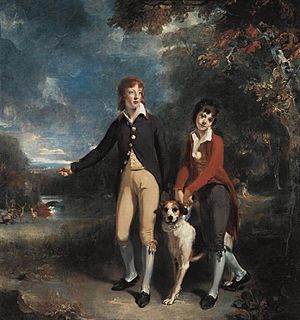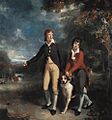William Talbot, 1st Earl Talbot facts for kids
Quick facts for kids
The Most Honourable
The Earl Talbot
|
|
|---|---|
| Lord Steward of the Household | |
| In office 1761–1782 |
|
| Monarch | George III |
| Preceded by | The Duke of Rutland |
| Succeeded by | The Earl of Carlisle |
| Member of Parliament for Glamorganshire |
|
| In office 1734–1737 |
|
| Preceded by | Sir Charles Kemeys |
| Succeeded by | Bussy Mansell |
| Personal details | |
| Born | 16 May 1710 Worcester, Worcestershire, England |
| Died | 27 April 1782 (aged 71) Lincoln's Inn Fields, Middlesex, England |
| Resting place | St Nicholas Church, Sutton, London |
| Political party | Opposition Whig |
| Spouse |
Mary de Cardonnel
(m. 1734; separated 1742) |
| Children | 2 (legitimate) |
| Education | Exeter College, Oxford |
William Talbot, 1st Earl Talbot (born May 16, 1710 – died April 27, 1782) was an important English politician. He was known as a Whig and held the title of Lord Steward of the Household. This was a high-ranking position in the royal household.
Before becoming an Earl, he was known as Lord Talbot from 1737 to 1761. He was a key figure among the Whig politicians who opposed King George II. Later, he joined the royal court when George II's grandson, George III, became king.
Contents
Early Life and Education
William Talbot was born in Worcester. He was the oldest surviving son of Charles Talbot, who later became Baron Talbot. His mother was Cecil Matthew.
William went to Eton from 1725 to 1728. After that, he studied at Exeter College, Oxford starting in 1727. He also attended Lincoln's Inn, a famous place for legal studies, in 1728. In 1736, he earned a special degree called Doctor of Civil Law (DCL).
Political Career Begins
In 1734, Talbot was elected as a Member of Parliament (MP) for Glamorganshire. He took over from a Tory MP named Sir Charles Kemeys. This area had been mostly controlled by Tory politicians for a long time.
Talbot ran as a Whig against Bussy Mansel, a local Tory. Talbot won the election by a small number of votes. This made him the first Whig to represent Glamorganshire in Parliament during the time of the Hanoverian succession.
In the House of Commons, Talbot joined the Opposition Whigs. This group was led by William Pulteney. They were against the government of Robert Walpole, who was a very powerful Prime Minister at the time.
Being a "Real Whig"
Talbot saw himself as a "real Whig." This meant he was quite independent in his political views. He worked with other independent Whigs like Sir Francis Dashwood and Earl Stanhope. These politicians believed in "Country principles."
These principles meant they were against certain government actions. They opposed the Septennial Act, which made parliamentary terms longer. They also spoke out against corruption and having a large standing army. Instead, they supported a local citizen army called the militia. They also wanted laws to limit how many government officials could be in Parliament. Their goal was to reduce the government's power over the House of Commons.
Opposing the Government
In Parliament, Talbot continued to oppose the ruling Whig government. He supported efforts to investigate the navy's operations. In February 1737, Talbot left his seat in the House of Commons. This happened because his father died, and he inherited the title of Baron Talbot. This meant he moved to the House of Lords.
Even though he was no longer in the Commons, Talbot remained an important figure among the opposition. In 1747, he and Dashwood met with Frederick, Prince of Wales. They were asked to help form a united opposition group in Parliament. This group included different types of Whigs and Tories. They agreed on a plan to oppose the government. Talbot remained a strong supporter of Prince Frederick until the Prince's death in 1751.
Serving the New King
When George III became king in 1760, Talbot played a special role. He acted as Lord High Steward during the new king's coronation ceremony. Soon after, in 1761, he was made a member of the Privy Council. This is a group of important advisors to the monarch.
On March 19, 1761, William Talbot was given the title of Earl Talbot. He was also appointed Lord Steward of the Household by Lord Bute. He held this important position in the royal household until he died. In January of that year, he also took command of the Glamorgan Militia, a local military force.
Talbot accepted these roles because he believed the new king, George III, was different from his grandfather. He thought George III's reign would bring positive changes. From then on, Talbot's politics generally aligned with the Court. He kept his household position and mostly stayed out of the big political debates of the day.
Family Life
William Talbot married Mary de Cardonnel on February 21, 1733. Mary was the daughter of Adam de Cardonnel, who had been a secretary to the famous Duke of Marlborough.
William and Mary had two children together: a daughter named Cecil and a son. Sadly, their son passed away before William did.
Because he had no sons who survived him, a special new title was created for William Talbot. On October 17, 1780, he was made Baron Dynevor of Dynevor. This title was set up so that it could pass to his daughter, Cecil, and then to her male children.
William Talbot passed away on April 27, 1782, at Lincoln's Inn Fields. He was buried at St Nicholas Church in Sutton. When he died, his title of Earl became extinct because he had no surviving male heirs. However, the barony of Talbot passed to his nephew. The barony of Dynevor went to his daughter, Cecil, and then to her eldest son.
Images for kids



